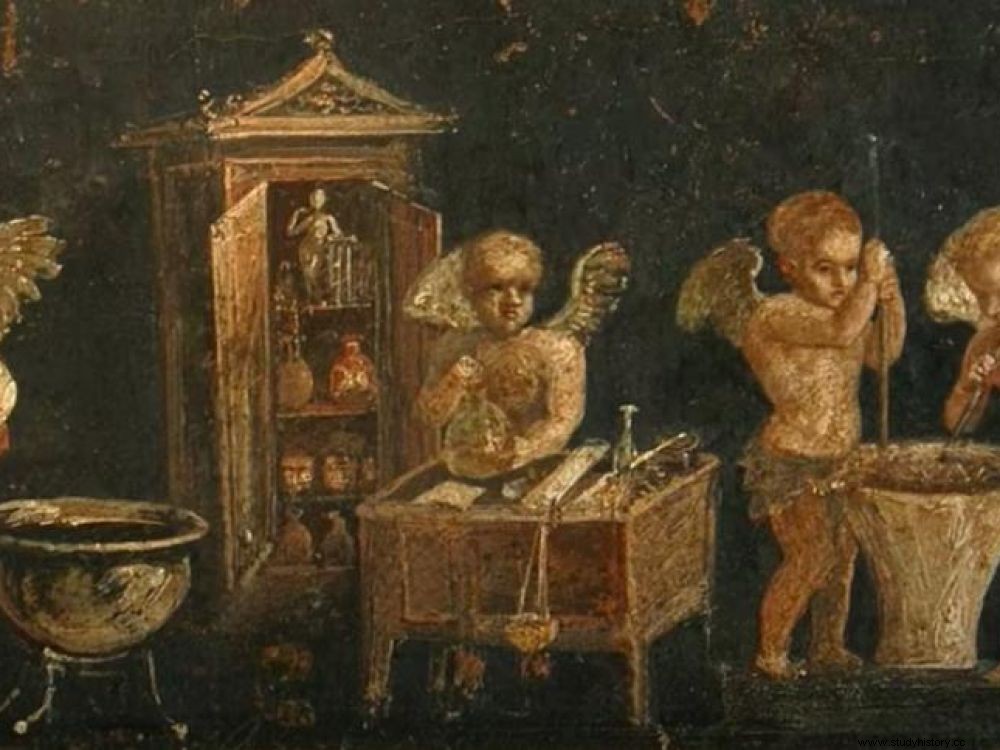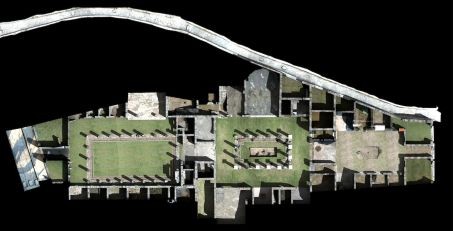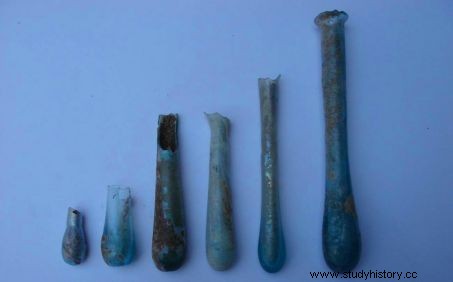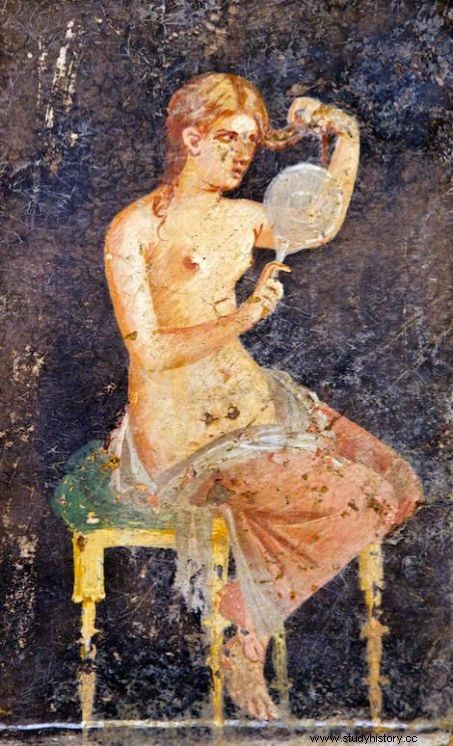One of the best preserved perfumeries in the Roman world has been found at the archaeological site of Pompeii, shedding light on the production chain of perfumes and ointments.

Fresco of the Perfumer Cupids in the Villa of the Vettii, on the site of Pompeii (Italy).
Perfume and ashes... The complete and recent study of a vast residence opening onto one of the busiest arteries of Pompeii, the famous Italian city of Campania, has made it possible to retrace the history of an exceptional workshop of perfumery. Located at the corner of via degli Augustali and Vicolo Storto , the ancient unguentaria possessed since its creation in the 2nd century BC, beautiful ointment jars in fine ceramics and as many innumerable fusiform vials in colored glass. If some had escaped the earthquake of 62, under the reign of Nero, they did not survive the tragedy of the year 79, under Vespasian... All these bluish bottles of oriental origin, these amphorae of all sizes, lamps, bowls , and many other glass objects disappeared along with the entire city and its inhabitants, engulfed in tons of lapilli and the burning ashes vomited by the nearby volcano. Spanish archaeologists from the University of Granada (UGR), the Valencian Institute for Conservation and Restoration of the Generalitat Valenciana and the Archeology Service of the City Council of Valence (SIAM), have just retraced the history of this perfumery, one of the best preserved of all Roman antiquity, in an article published in the journal Archeopress Arch eology * after work started in 2004.
“This workshop was located in the south-west part of the Maison d'Ariane, a domus of more than 2,000 m2 located opposite the macellum, the great central market of Pompeii. A second access to the north opened on via della Fortuna, in the heart of the district of the most luxurious houses in the city, such as the House of the Faun” , explains Macarena Bustamante-Álvarez, researcher at the University of Granada (UGR), Spain, one of the authors of the publication, joined by Sciences et Avenir. The study of this production complex in the nerve center of the city has above all enabled the Spanish experts to analyze the entire perfumery production chain. By delivering unknown data on how these essences were produced. “In Pompeii, perfumes were made continuously, from the 2nd century BC, to the eruption of Vesuvius in 79 ”, says Albert Ribera, co-signer of the article.

3D photogrammetric plan of the House of Ariadne, one of the largest domus (homes) in the city of Pompeii. © University of Granada
The manufacture of perfumes and ointments
Perfume and ashes... The complete and recent study of a vast residence opening onto one of the busiest arteries of Pompeii, the famous Italian city of Campania, has made it possible to retrace the history of an exceptional workshop of perfumery. Located at the corner of via degli Augustali and Vicolo Storto , the ancient unguentaria possessed since its creation in the 2nd century BC, beautiful ointment jars in fine ceramics and as many innumerable fusiform vials in colored glass. If some had escaped the earthquake of 62, under the reign of Nero, they did not survive the tragedy of the year 79, under Vespasian... All these bluish bottles of oriental origin, these amphorae of all sizes, lamps, bowls , and many other glass objects disappeared along with the entire city and its inhabitants, engulfed in tons of lapilli and the burning ashes vomited by the nearby volcano. Spanish archaeologists from the University of Granada (UGR), the Valencian Institute for Conservation and Restoration of the Generalitat Valenciana and the Archeology Service of the City Council of Valence (SIAM), have just retraced the history of this perfumery, one of the best preserved of all Roman antiquity, in an article published in the journal Archeopress Archeology * after work started in 2004.
“This workshop was located in the south-west part of the Maison d’Ariane, a domus of more than 2,000 m 2 located in front of the macellum, the great central market of Pompeii. A second access to the north opened on via della Fortuna, in the heart of the district of the most luxurious houses in the city, such as the House of the Faun” , explains Macarena Bustamante-Álvarez, researcher at the University of Granada (UGR), Spain, one of the authors of the publication, joined by Sciences et Avenir. The study of this production complex in the nerve center of the city has above all enabled the Spanish experts to analyze the entire perfumery production chain. By delivering unknown data on how these essences were produced. “In Pompeii, perfumes were made without interruption, from the 2 th century BC, when Vesuvius erupted in 79 ”, says Albert Ribera, co-signer of the article.

3D photogrammetric plan of the House of Ariadne, one of the largest domus (homes) in the city of Pompeii. Credits:Proyecto casa de Ariadna. Valencia (SIAM). Archaeological Museum of Alicante (MARQ)
The manufacture of perfumes and ointments
“The first step in the development of Roman perfumes was to press olives and flowers to obtain the oily base of the product ”, say the researchers. And to do this, presses had to be at hand. “The need to use "fresh" oils therefore led to the installation of pressing systems in the perfumeries themselves ”, specifies Macarena Bustamante-Álvarez. Vestiges of it were found in the workshop located south of the Maison d'Ariane. In the center of the dwelling, on the other hand, was a large space for the treatment of aromatic flowers, for the production of essences. While in the northern part, the one giving access to Via della Fortuna , a series of basins was unearthed. Located outside, there was processed … animal wool. The processing of wool was indeed complementary to the production of perfume. In these lanificari (name given to these places) was washed and degreased the dirty fleece of the barely shorn animals. From these first washes, a fat was extracted by purification, the suint, which served as a base for certain cosmetic preparations. Thus, Pliny said “that the fat resulting from the washing of wool, the oesypum ( equivalent to modern lanolin, a rare product of animal origin still authorized in current cosmetics Editor's note), was used to give the skin a smoother complexion, free of spots and moles !” For the binders, these are gelatins of animal origin, mainly from the heads and lower limbs of suids, which were used in the maceration of the essences. This was confirmed by a large quantity of pig bones, collected during the excavations. “Other studies carried out on the site of Pompeii have also shown the importance of this gelatinous contribution to achieve the agglutination of floral essences and refined oil” , say the researchers.

Details of ointment bottles found in Ariadne's House. © University of Granada
The role of perfumes in the Roman world
From the 2 th century BC, the general adoption of Eastern and Hellenistic practices by the Roman population mostly occurred with the arrival of Greek culture. “But these cosmetic treatments had already affected since the 6 e century BC the southern part of the peninsula, with the Etruscans of Campania and the Greeks of Magnia Greciae , continue the authors. And an interest in the use of perfumes and scented oils quickly developed with a marked taste for those coming from Campania and its cities of Pompeii as much as Capua”. Didn't Pliny claim that Campania roses “were more fragrant than the others?”

Body care and women with mirrors in Roman antiquity, fresco from the Maison d'Ariane. © AFP
From being elitist, the use of perfumes has spread to all spheres of daily life
“Drinks, food, temples and streets were all fragrant. The use of perfume in votive offerings and funerals is also attested ”, remind the authors. Perfumeries have become very common in all cities of the Empire. Perfumes that were used for body care and the pleasure of the senses in the private space, but which could also be used in the public one. They were used in many ways, to perfume the baths, in the thermal baths, or even, more surprisingly, at the time of gladiator encounters, as was apparently the case during games organized for the Emperor Claudius.
The perfumery activity of the Maison d'Ariane, the second of its type known in Pompeii, nevertheless seems to have slowed down around the year 62, when after the earthquake, the owner, no doubt enriched by this perfume production, decided to convert his vast residence into a luxury residence…, a project that the eruption of Vesuvius did not allow him to carry out.
* Production Moments and Areas in a Big House in Pompeii:The House of Ariadne from the 2nd Century BC to AD 79, Archaeopress Archaeology, Oxford, 2020
